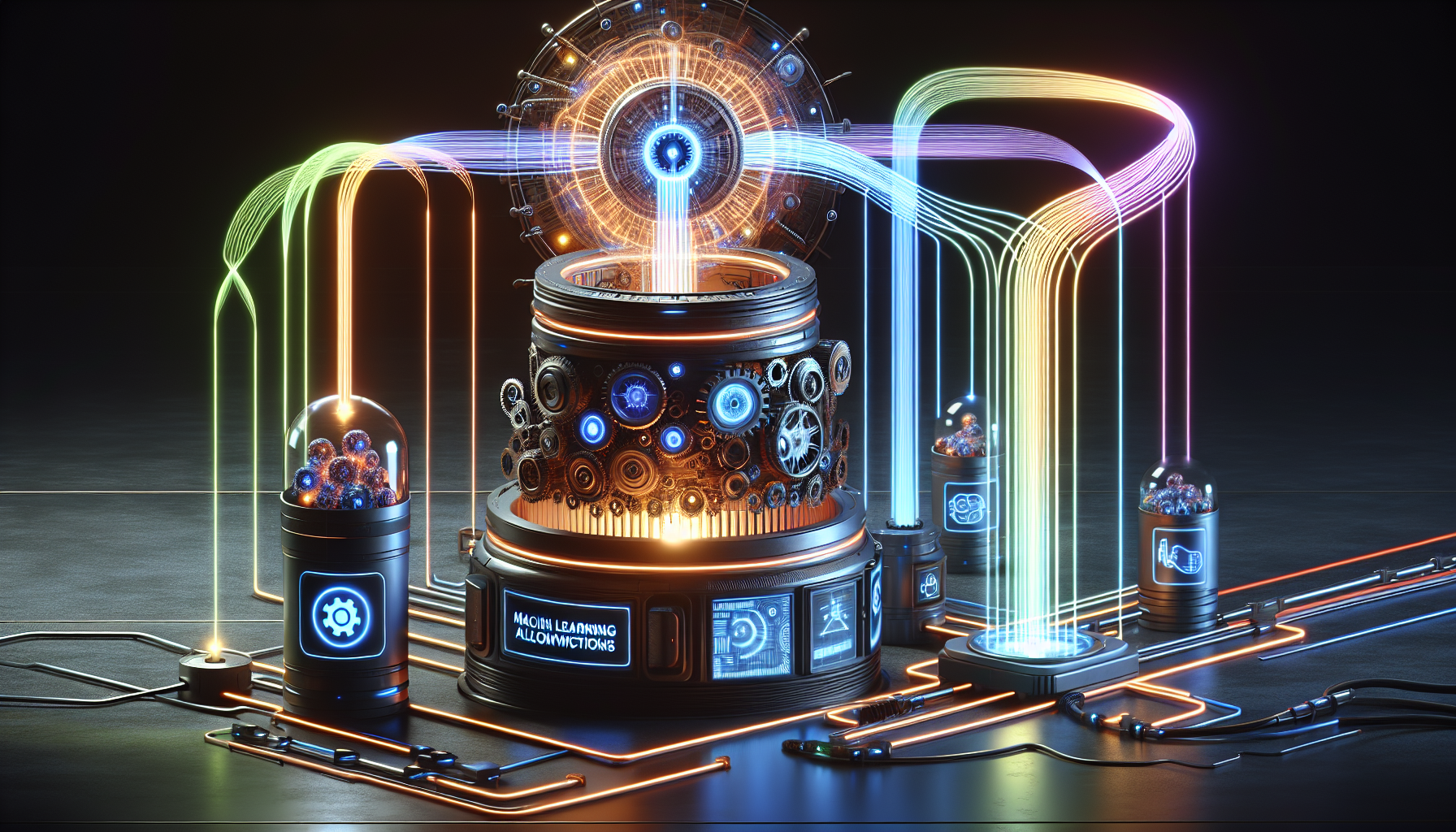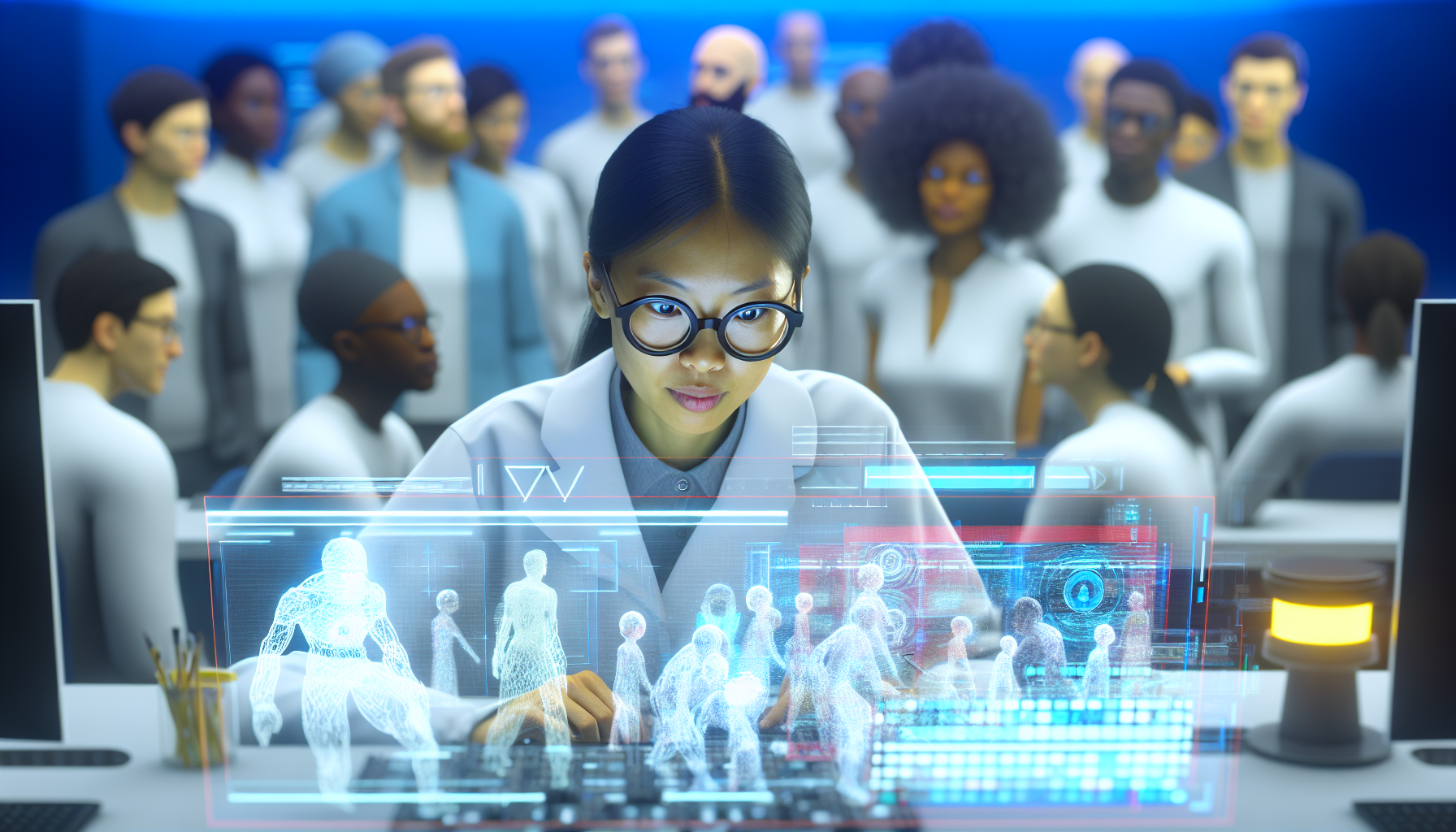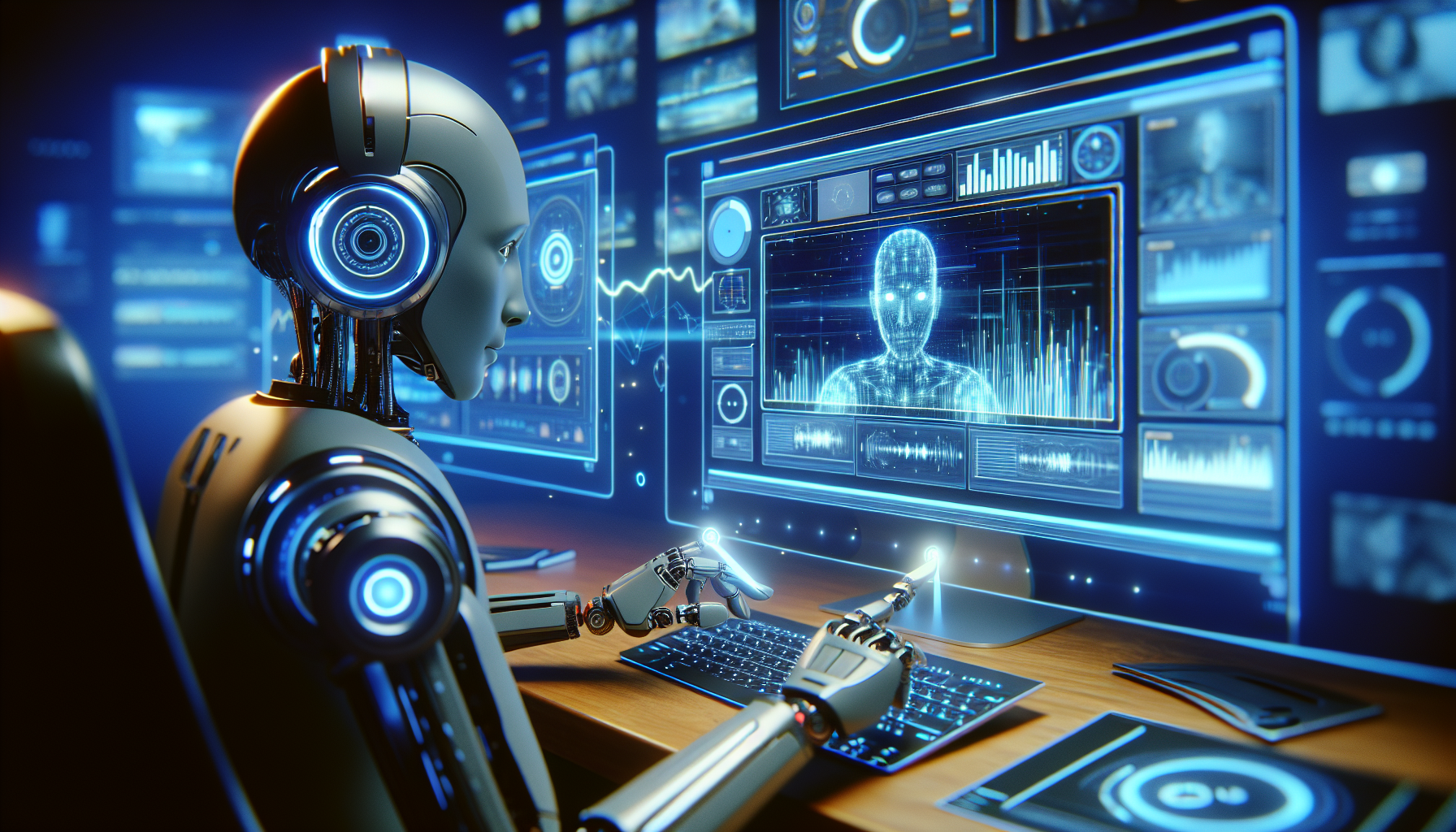Diving into the realm of artificial intelligence (AI), one can’t help but marvel at the leaps and bounds this technology has made in recent years. Particularly in the field of video production, AI has been a game-changer. Whether it’s creating visually stunning videos or trimming down hours of footage into concise, engaging clips, the capabilities of AI are nothing short of revolutionary. But how does AI video generation work? And what sets it apart from traditional video production methods? Let’s find out!
Key Takeaways
AI video generators utilize machine learning, computer vision, and NLP to understand user inputs and create engaging and personalized video content quickly, automating and streamlining traditional video production processes.
Advanced AI models, computer vision, and NLP work together in AI video generators to interpret prompts, produce relevant visual narratives, and refine the quality of video output through processes such as input analysis, video synthesis, and refinement stages.
Ethical considerations are paramount in the deployment of AI video generators, with the technology presenting risks like generating fake content and bias, necessitating responsible use and considerations for the societal impact.
Unveiling AI Video Generation

At its core, AI video generation is all about harnessing the power of machine learning and natural language processing to create videos based on user inputs. But it’s not just about stitching together clips or adding fancy transitions. AI video generators are capable of:
Understanding the context and intent behind user prompts
Translating this understanding into visually engaging videos
Doing it in a fraction of the time it would take a human editor.
While traditional video production methods involve shooting footage, sorting through countless clips, and laborious editing, AI video generators streamline the process by:
Creating video content from scratch, based on the user’s instructions
Supplementing lacking stock video
Influencing video results
Automating repetitive tasks in the creative workflow
These capabilities make AI video generators an indispensable tool in today’s fast-paced digital landscape.
The Inner Workings of AI Video Generators

Having introduced AI video generation, it’s time to explore the technology that powers it. The magic of AI video generators lies in their ability to combine various AI models, computer vision techniques, and natural language processing to create visually appealing and engaging videos. These subfields of AI play a crucial role in the functioning of AI video generators.
They use machine learning algorithms to analyze a diverse range of data, such as images, videos, and text, thereby learning from each interaction and refining their algorithms over time. The result? More realistic and engaging videos.
From Concept to Content: The AI Model
Video generation heavily relies on AI models. They analyze user inputs by employing techniques such as text-to-video conversion, deep learning algorithms, and generative models. These models are capable of generating videos based on prompts, URLs, PowerPoint presentations, or other input formats. Furthermore, AI models employ generative modeling techniques to comprehend the structure of the dataset and produce comparable instances.
By combining neural networks with user behavior analysis, these models can tailor video content to individual preferences, ensuring relevance. This, coupled with the ability to analyze trends and historical data, enables AI models to generate creative and personalized content.
Crafting Visual Narratives: Computer Vision at Play
Computer vision is another key player in the realm of AI video generation. By instructing computers to perceive and comprehend information conveyed through image and video data, computer vision allows AI video generators to automate the process of creating video content. It integrates AI technologies, including machine learning, with computer vision to analyze and comprehend video data, extract valuable insights, and produce novel video content based on the derived analysis.
From person or object detection to facial recognition and activity recognition, computer vision is fundamentally changing the way we create videos.
Bringing Stories to Life: Natural Language Processing
Natural language processing (NLP) is another integral component in bringing stories to life. By aiding in the identification of meaning, intention, and emotion in textual content, NLP allows computers to comprehend, interpret, and produce human language. This translation of user input into actionable directives for the creation of video content is a game-changer in the world of video production.
Moreover, by extracting essential concepts from textual input and converting them into relevant visual elements, NLP ensures that the produced content is coherent and faithfully represents the user’s intentions and the emotions expressed in the text.
The Step-by-Step Process of Generating Videos with AI

How does all of this come together? Video generation with AI starts during the input analysis phase. This involves the examination of provided data, including images, videos, and text, and the use of natural language processing and deep learning algorithms to extract relevant information and features. This phase is essential for understanding the user’s query or input and strategizing how to translate it into corresponding visuals for the video.
Following that, the video creation process enters the video synthesis phase, which involves the following steps:
Data collection
Storyboard creation
Preset template configuration
Integration of elements such as transitions, visual effects, and music.
Refinement and quality control make up the final stage, deploying techniques such as:
Background noise removal
Video and audio track quality enhancement
The use of Generative Adversarial Networks (GANs) to boost efficiency and realism in the synthesized video.
Input Analysis: Understanding User Prompts
Input analysis is the first and arguably the most critical step in the AI video generation process. It involves understanding a variety of user prompts, including:
text
words
phrases
images
video clips
audio voice clips
By employing Natural Language Processing (NLP), AI video generators are able to comprehend and interpret these prompts, translating user input into actionable directives for the creation of video content.
This understanding of user prompts plays a crucial role in guiding the subsequent steps in AI video generation. It provides direction on the desired:
Content
Style
Theme
Specific elements
Ensure that the artificial intelligence should incorporate video footage in the video.
Video Synthesis: Creating the Footage
The video synthesis phase involves the following steps:
Data collection
Storyboard generation
Configuration of preset templates
Inclusion of elements like transitions, visual effects, and music
Analysis of text, images, and audio to create a coherent video output
This phase begins once the AI video generator comprehends the user prompts.
By leveraging deep learning techniques and neural networks, AI video generators are able to analyze and process visual content from images, videos, and other inputs, enabling computers to identify and classify elements such as objects, people, actions, or events.
Refinement and Quality Control: Perfecting the Output
Refinement and quality control marks the final stage in the AI video generation process. This involves improving the quality of the AI-generated video by employing algorithms and deep learning techniques to analyze and process data. Techniques such as removing background noise, enhancing the quality of video and audio tracks, and utilizing Generative Adversarial Networks (GANs) are employed in AI video generation technology to improve efficiency and realism in the synthesized video.
This ensures that the produced content is of high quality and visually appealing, aligning with the user’s expectations and the quality standards of today’s digital landscape.
The Evolution of Video Editing with AI Technology

The adoption of AI technology has spurred significant advancements in video editing. Over the past decade, we’ve seen a shift from basic video analysis and object recognition to AI-supported editing aimed at improving productivity and streamlining repetitive activities.
With automated editing features such as:
analyzing audio and video signals to automatically remove background noise
enhance voice clarity
auto-generate transcripts
assist in video clip refining and trimming
AI has reshaped the landscape of how we edit videos and the overall video editing process.
Automated Editing Features
The advent of automated editing features is a significant advancement in AI video editing technology. These features provide functions such as:
analyzing audio and video signals to automatically remove background noise
enhancing voice clarity
auto-generating transcripts
assisting in video clip refining and trimming
By automating these laborious and time-consuming tasks, AI technology not only enhances the quality of the video but also significantly reduces the time and effort involved in the editing process.
Enhancing Creativity: AI’s Role in Video Aesthetics
Beyond task automation, AI technology has also broadened the scope for creativity in video editing. By generating unique visual elements and suggesting creative editing decisions, AI technology enhances video aesthetics and makes videos more engaging.
Whether it’s creating personalized visuals or generating surreal and innovative videos that challenge conventional filmmaking, AI technology is pushing the boundaries of creativity in video editing.
The Benefits of Using AI Video Generators

AI video generators offer a multitude of advantages, including:
Automating laborious tasks
Saving time
Streamlining the video production process
Enabling content creators to focus more on the creative aspects of their work
Furthermore, AI video generators also enable the creation of personalized video content at scale, which is crucial for optimizing customer reach and conversion rates.
Speed and Efficiency in Video Production
AI video generators provide notable benefits, especially in enhancing speed and efficiency in video production. This technology can help streamline the entire process, allowing for quicker and more cost-effective content creation. By automating tasks such as:
cutting
trimming
applying transitions
applying effects
AI video generators, such as an ai video generation tool, can significantly reduce the time it takes to produce a video. This not only allows filmmakers to produce high-quality videos in a fraction of the time but also enables them to focus on other important aspects of video production such as storytelling and visual aesthetics.
Customization at Scale: Personalized Video Content
Creating personalized video content at scale is another significant advantage of using AI video generators. By utilizing deep learning algorithms and machine learning techniques, AI video generators are able to autonomously create or improve video content, creating a personalized viewing experience for each individual viewer.
Whether it’s dynamically updating video content based on user interactions or creating personalized visuals for targeted customer groups, AI video generators are revolutionizing the way we create and consume video content.
Ethical Considerations in AI Video Generation
While AI video generators present numerous benefits, we must remain cognizant of the ethical implications tied to their use. Some of the ethical considerations include:
The potential to produce fake content that can harm individuals’ reputations and mislead audiences
The need for strategies to mitigate biases in AI-generated videos
The responsibility to ensure that AI-generated videos are used responsibly and ethically
These ethical and societal considerations require careful thought and action to ensure that AI video generators are used in a responsible and beneficial manner.
It’s essential to balance innovation with ethical responsibility to ensure sustainable and accepted use of AI in video content creation.
Popular AI Video Generators on the Market
Choosing the right AI video generator from the myriad available options can be challenging. Some require longer texts such as blogs or video scripts for content creation, while others can operate with concise sentences. Additionally, some AI video generators provide built-in editing tools, while others offer distinctive features based on the platform.
Popular choices include Synthesia, acclaimed for its text-to-video conversion capabilities, and DeepBrain AI, recognized for its AI human avatars and studio backgrounds.
Text to Video Pioneers
Among the popular AI video generators on the market, text-to-video pioneers like Synthesia have carved out a niche for themselves. By using AI to convert text inputs into video content, these platforms have revolutionized the way we create videos. Some popular AI video generators include:
Synthesia
Lumen5
Wibbitz
Content Samurai
These platforms offer a range of features and capabilities to help users create professional-looking videos quickly and easily.
With features like custom AI avatars, AI voices available in multiple languages, and a variety of video templates that can be edited with custom footage, these platforms offer a new and exciting way to create engaging videos.
Avatars and Animated Characters
Avatar-based AI video generators, on the other hand, focus on creating engaging videos using AI-generated characters and animations. These platforms, such as DeepBrain AI, use sophisticated algorithms to produce inventive and imaginative avatars, introducing a unique element to video content that captivates the audience.
Whether it’s creating personalized visuals or generating surreal and innovative videos, these platforms are pushing the boundaries of creativity in both video editing and video creation.
Tips for Creating Effective AI-Generated Videos
Regardless of whether you’re a seasoned video editor or a novice in AI video generation, certain tips can assist you in crafting effective AI-generated videos. These include maintaining clarity in scripting, selecting suitable templates and styles, and leveraging AI-generated voices and sounds.
By following these tips, you can make the most of AI video generators and generate video content that is high-quality, engaging videos that resonate with your audience.
Clarity in Scripting
Ensuring clear and concise scripting is the initial step towards creating an effective AI-generated video. A well-crafted script is essential as it facilitates effective synthesis of AI-generated voices and aligns with the intended tone and style of the video.
By maintaining clarity in scripting, you can ensure that the AI video generator fully understands the desired content and style, resulting in a video that accurately communicates your message to the audience.
Selecting Suitable Templates and Styles
Selecting suitable templates and styles, which resonate with the intended message and audience, is another crucial tip. When selecting templates and styles, consider factors such as the duration, mood, and subject matter of the video. Utilizing a diverse range of templates available on platforms such as Canva and Synthesia can streamline the process and uphold a consistent visual identity, which is essential for brand representation.
By tailoring these templates, you can ensure that the video resonates with the intended message and target audience, thereby influencing its overall effectiveness.
Leveraging AI Voices and Sounds
Lastly, make sure to utilize AI-generated voices and sounds. These can add a whole new dimension to your videos, creating a more engaging and immersive viewing experience for your audience. To effectively utilize AI-generated voices and sounds, begin by drafting a script for the video. Following this, select an appropriate Text-to-Speech (TTS) application and customize the voice settings to align with the intended tone.
Implement the script using the selected AI voice and then proceed to edit the video while synchronizing the voiceover to maintain a polished sound throughout the video.
Summary
In conclusion, AI video generation has revolutionized the video production process, offering a faster and more efficient alternative to traditional methods. By utilizing machine learning algorithms, deep learning techniques, and natural language processing, AI video generators can create high-quality videos that are visually stunning and engaging. However, as with any technology, it’s essential to consider the ethical implications and strive for transparency and fairness. With careful planning and the right tools, AI video generators can be a powerful ally in video production, helping you create compelling videos that resonate with your audience.
Frequently Asked Questions
How are AI generated videos made?
AI generated videos are made using AI video generators, which utilize machine learning and computer vision to analyze data and create visually appealing videos through automation.
How can AI be used in video production?
AI can be used in video production to automate repetitive tasks such as camera control and lighting adjustment, saving time and enabling the capture of more footage.
How does AI video enhancement work?
AI video enhancers use generative AI to analyze videos and apply effects like noise removal and stabilization, using machine learning and neural network techniques to improve video quality.
What are the benefits of using AI video generators?
Using AI video generators can increase speed and efficiency in video production, while also enabling the creation of personalized video content at scale.
What are some popular AI video generators on the market?
Synthesia and DeepBrain AI are popular AI video generators on the market, known for their text-to-video and avatar-based capabilities.

Comments